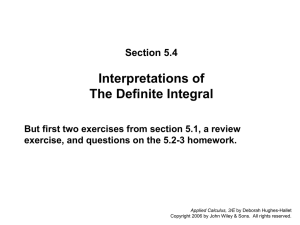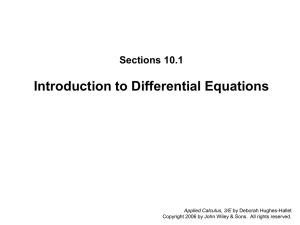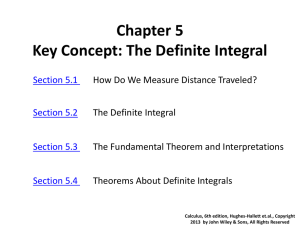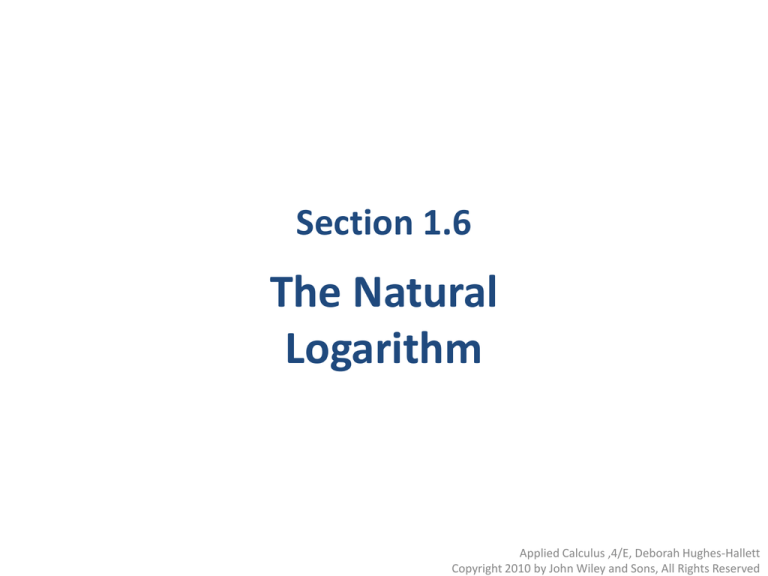
Section 1.6
The Natural
Logarithm
Applied Calculus ,4/E, Deborah Hughes-Hallett
Copyright 2010 by John Wiley and Sons, All Rights Reserved
Figure 1.63: The natural logarithm function climbs very slowly.
Applied Calculus ,4/E, Deborah Hughes-Hallett
Copyright 2010 by John Wiley and Sons, All Rights Reserved
Applied Calculus ,4/E, Deborah Hughes-Hallett
Copyright 2010 by John Wiley and Sons, All Rights Reserved
Converting the function P = 100(1.07)t to the
form P = P0ekt gives
(a) P = 100e1.07t
(b) P = 100e0.07t
(c) P = 100e1.0677t
(d) P = 100e0.0677t
(e) P = 100e0.93t
ConcepTest • Section 1.6 • Question 5
Converting the function P = 750e0.04t to the
form P = P0at gives
(a) P = 750(1.04)t
(b) P = 750(0.04)t
(c) P = 750(1.0408)t
(d) P = 750(0.0408)t
(e) P = 750(0.96)t
ConcepTest • Section 1.6 • Question 6
The solution to 200 = 30e0.15t is:
ln(200 / 30)
(a) t
ln(0.15)
ln(200 / 30)
(b) t
0.15
200
(c) t ln
30
(0.15)
200
(d) t
ln(0.15)
30
ConcepTest • Section 1.6 • Question 8
Solve for x if y = e + 2x.
ln y 1
(a) x
ln 2
ln( y 1)
(b) x
ln 2
ln y
(c) x
1
ln 2
ln( y e )
(d) x
ln 2
ConcepTest • Section 1.6 • Question 17
Section 1.7
Exponential
Growth and Decay
Applied Calculus ,4/E, Deborah Hughes-Hallett
Copyright 2010 by John Wiley and Sons, All Rights Reserved
For a growth rate of 8% compounded annually, what is the doubling time?
2 = (1.08)𝑡 implies 𝑡 =
ln 2
ln 1.08
≈ 9.0 years
For a growth rate of 8% compounded monthly, what is the doubling time?
2 = (1 +
0.08
12
12𝑡
)
implies 𝑡 =
ln 2
12ln 1.00667
≈ 8.7 years
For a growth rate of 8% compounded continuously, what is the doubling
time?
ln 2
2 = 𝑒 0.08𝑡 implies 𝑡 =
≈ 8.7 years
0.08
Applied Calculus ,4/E, Deborah Hughes-Hallett
Copyright 2010 by John Wiley and Sons, All Rights Reserved
The half-life of nicotine in the blood is 2 hours. A person absorbs 0.4 mg
of nicotine by smoking a cigarette. Fill in the following table with the
amount of nicotine remaining in the blood after t hours.
t (hours)
0
Nicotine (mg)
0.4
2
0.2
4
0.1
6
8
10
0.05 0.025 0.0125
Estimate when the amount of nicotine is reduced to 0.04 mg.
0.04 = 0.4(12)𝑡/2 implies 𝑡 = 2
ln 0.1
ln 0.5
≈ 6.6
What is the decay rate?
1−
1
1 2
2
≈ 0.29 implies 29% per hour
Applied Calculus ,4/E, Deborah Hughes-Hallett
Copyright 2010 by John Wiley and Sons, All Rights Reserved
Estimate the half-life for the exponential
decay shown in Figure 1.9.
3
Figure 1.9
ConcepTest • Section 1.7 • Question 10
By Wednesday …
• Complete 1.5-7 HW
• Complete Lab 01
• Read 1.8
Applied Calculus ,4/E, Deborah HughesHallett Copyright 2010 by John Wiley and
Sons, All Rights Reserved

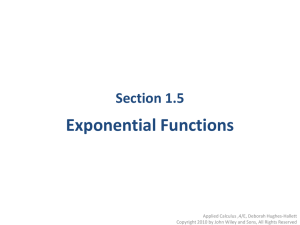
![Global max/min [4.3]](http://s2.studylib.net/store/data/005700750_1-6d8aea91972157c1c45aa1008072a9fe-300x300.png)
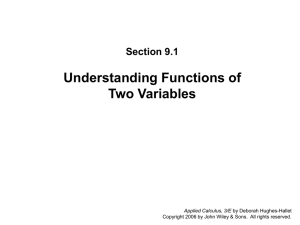
![Local max/min [4.1]](http://s2.studylib.net/store/data/005703785_1-fddedba53a949b6dd73bfcae3f9e6954-300x300.png)
![Inflection points [4.2]](http://s2.studylib.net/store/data/005711558_1-7e6caa30b78ed23b978b40c18112cd02-300x300.png)
![Partial derivatives [9.3]](http://s3.studylib.net/store/data/009572016_1-92c0e9c22c1deb5ae72568562d485794-300x300.png)
